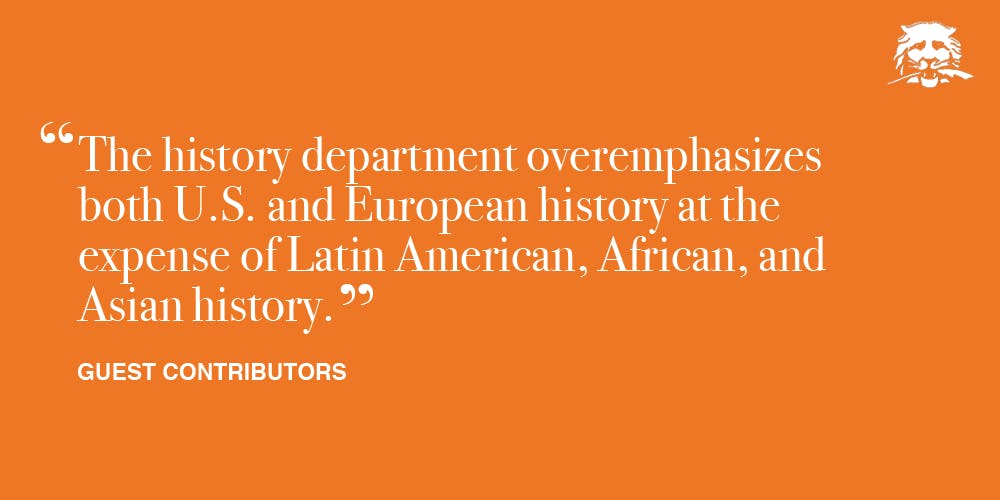In the fall of 2018, Princeton’s history department will offer sixty-four courses. Of those courses, none are cross-listed with the Program in Latin American Studies. Only one, a junior seminar open only to juniors in the history department, addresses a Latin American topic: U.S. Imperialism in the Modern Caribbean.
This dearth of courses is not a product of lack of demand for HIS/LAS classes. In the Class of 2017, there were 26 students in the interdisciplinary Program in Latin American Studies. Enrollments in LAS-crosslisted history classes — when those classes have been offered — have been consistently high, especially in those classes covering the modern period. The last time the survey course HIS/LAS 304: Modern Latin America since 1810 was offered, in spring 2016, 48 students enrolled. Latin American history seminars offered since then have often been filled to capacity, or nearly so.
When this issue was raised with history department faculty at a meeting to discuss the undergraduate program, the faculty members present seemed unaware of the lack of LAS courses. They responded to our concerns by referring to the tentative list of spring 2019 course offerings, which includes two Latin American history courses. However, this does not resolve either the immediate problem of next fall’s offerings, nor the more systemic issue at hand: how could one of the best history departments in the country fail to offer, at both the undergraduate and graduate levels, any courses on Latin America?
Part of the problem stems from the lack of history faculty working on Latin America: only three history professors list “Latin America and the Caribbean” as one of their regions of interest. Of those professors, one will be on leave this coming year, and another has transitioned to teaching mostly global history. The third, who is teaching the two courses offered next spring, will be leaving the University at the end of the 2018-2019 academic year.
This shortage of faculty, however, only speaks to a deeper problem. The history department overemphasizes both U.S. and European history at the expense of Latin American, African, and Asian history. Tellingly, the department’s distribution requirements for concentrators include one class each in U.S., European, Pre-Modern, and “Non-Western” history. The distribution of comprehensive exams (taken by seniors after the submission of the senior thesis, and worth five percent of their departmental GPA) also reveals the department’s bias towards the United States and Europe (to the department’s credit, it is considering revisions to the comprehensive exam system, but it is unclear what form these changes will take, and what fields will be offered). Under the current system, Latin American history concentrators take a comprehensive exam that covers the entire region, including both colonial and modern periods. There is one “African” exam and one “Asian” exam offered. European concentrators choose from exams covering Ancient Greece and Rome, Europe since 1700, Medieval and Renaissance Europe, Russia, and the United Kingdom. U.S. history concentrators take their exam on the post-independence United States. What does this say about how the department values the histories of different parts of the world? Is it a coincidence that the areas of the world that the department focuses on are predominantly white?
Princeton has historically been a place designed for white students and faculty members, and the department’s curriculum reflects this in its Anglo-American bias. To demonstrate our desire to break away from this history, the department must improve its coverage of people and parts of the world that have been traditionally marginalized by the discipline, through both courses and faculty hiring decisions.
It is not unreasonable to expect the University to hire more faculty and offer more courses in Latin American history. Brown University’s history department has eight faculty members focusing on Latin America and the Caribbean, and Yale’s has six. This coming fall, Brown will offer four undergraduate classes on Latin American history. Yale’s course offerings for fall 2018 have not yet been released, but three undergraduate Latin American history classes were offered this spring, and four were offered last fall. We believe that this is a valuable and informative comparison, given that all three institutions have similar undergraduate student bodies: 5,232 at Princeton; 5,453 at Yale; 6,670 at Brown.
Every region of the world deserves inclusion in Princeton’s history curriculum. Latin America comprises thirty-three countries and approximately 637 million people. Some of these countries are global economic powerhouses, some have been featured on the front page of The New York Times, and many have played central roles in global conflicts and the development and spread of ideas throughout history. Any understanding of the history of our world is incomplete without knowledge of this region, and the courses offered by our history department should reflect that. The stories of the places and people in Latin America matter, just as much as those of the United States and Europe.
We care deeply about the history department, and want it to provide the best education possible to its students and the many non-concentrators that enroll in its classes. We feel that a more diverse and inclusive program of study is integral to that goal.
Aly Kersley and Kate Reed are juniors in the history department and Program in Latin American Studies. Aly is from Toronto, Canada, and can be reached at akersley@princeton.edu. Kate is from Annapolis, Md., and can be reached at kreed@princeton.edu.









